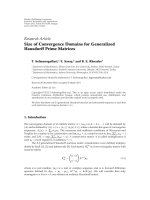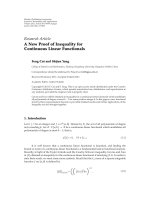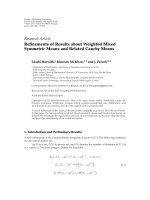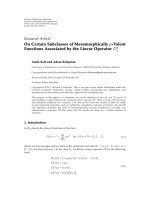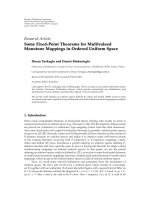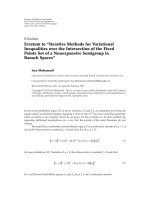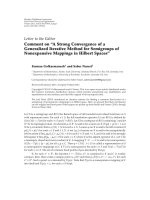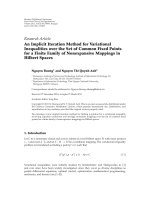Hindawi Publishing Corporation Fixed Point Theory and Applications Volume 2011, Article ID 309026, pptx
Bạn đang xem bản rút gọn của tài liệu. Xem và tải ngay bản đầy đủ của tài liệu tại đây (496.58 KB, 11 trang )
Hindawi Publishing Corporation
Fixed Point Theory and Applications
Volume 2011, Article ID 309026, 11 pages
doi:10.1155/2011/309026
Research Article
Generalized Hyers-Ulam Stability of
the Pexiderized Cauchy Functional Equation in
Non-Archimedean Spaces
Abbas Najati
1
and Yeol Je Cho
2
1
Department of Mathematics, Faculty of Sciences, University of Mohaghegh Ardabili,
Ardabil 56199-11367, Iran
2
Department of Mathematics Education and the RINS, Gyeongsang National University,
Jinju 660-701, Republic of Korea
Correspondence should be addressed to Yeol Je Cho,
Received 22 October 2010; Accepted 8 March 2011
Academic Editor: Jong Kim
Copyright q 2011 A. Najati and Y. J. Cho. This is an open access article distributed under the
Creative Commons Attribution License, which permits unrestricted use, distribution, and
reproduction in any medium, provided the original work is properly cited.
We prove the generalized Hyers-Ulam stability of the Pexiderized Cauchy functional equation
fx ygxhy in non-Archimedean spaces.
1. Introduction
The stability problem of functional equations was originated from a question of Ulam 1
concerning the stability of group homomorphisms.
Let G
1
be a group and let G
2
be a metric group with the metric d·, ·.Given>0,
does there exist a δ>0 such that, if a function h : G
1
→ G
2
satisfies the inequality
dhxy,hxhy <δfor all x,y ∈ G
1
, then there exists a homomorphism H : G
1
→ G
2
with dhx,Hx <for all x ∈ G
1
?
In other words, we are looking for situations when the homomorphisms are stable,
that is, if a mapping is almost a homomorphism, then there exists a true homomorphism
near it. If we turn our attention to the case of functional equations, we can ask the following
question.
When the solutions of an equation differing slightly from a given one must be close to
the true solution of the given equation.
For Banach spaces, the Ulam problem was first solved by Hyers 2 in 1941, which
states that, if δ>0andf : X → Y is a mapping, where X, Y are Banach spaces, such that
f
x y
− f
x
− f
y
Y
≤ δ 1.1
2 Fixed Point Theory and Applications
for all x, y ∈ X, then there exists a unique additive mapping T : X → Y such that
f
x
− T
x
Y
≤ δ 1.2
for all x ∈ X. Rassias 3 succeeded in extending the result of Hyers by weakening the
condition for the Cauchy difference to be unbounded. A number of mathematicians were
attracted to this result of Rassias and stimulated to investigate the stability problems of
functional equations. The stability phenomenon that was introduced and proved by Rassias
is called the generalized Hyers-Ulam stability. Forti 4 and G
˘
avrut¸a 5 have generalized the
result of Rassias, which permitted the Cauchy difference to become arbitrary unbounded.
The stability problems of several functional equations have been extensively investigated by
a number of authors, and there are many interesting results concerning this problem. A large
list of references can be found, for example, in 3, 6–30.
Definition 1.1. AfieldK equipped with a function valuation |·|from K into 0, ∞ is called
a non-Archimedean field if the function |·|: K → 0, ∞ satisfies the following conditions:
1 |r| 0 if and only if r 0;
2 |rs| |r||s|;
3
|r s|≤max{|r|, |s|} for all r, s ∈ K.
Clearly, |1| |−1| 1and|n|≤1 for all n ∈ N.
Definition 1.2. Let X be a vector space over scaler field K with a non-Archimedean nontrivial
valuation |·|.Afunction·: X → R is a non-Archimedean norm valuation if it satisfies the
following conditions:
1
x 0 if and only if x 0;
2
rx |r|x;
3
the strong triangle inequality, namely,
x y
≤ max
x
,
y
1.3
for all x, y ∈ X and r ∈ K.
The pair X, · is called a non-Archimedean space if ·is non-Archimedean norm
on X.
It follows from 3
that
x
n
− x
m
≤ max
x
j1
− x
j
: m ≤ j ≤ n − 1
1.4
for all x
n
,x
m
∈ X, where m, n ∈ N with n>m. Therefore, a sequence {x
n
} is a Cauchy
sequence in non-Archimedean space X, · if and only if the sequence {x
n1
−x
n
} converges
Fixed Point Theory and Applications 3
to zero in X, ·. In a complete non-Archimedean space, every Cauchy sequence is
convergent.
In 1897, Hensel 31 discovered the p-adic number as a number theoretical analogue
of power series in complex analysis. Fix a prime number p. For any nonzero rational number
x, there exists a unique integer n
x
∈ Z such that x a/bp
n
x
, where a and b are integers not
divisible by p. Then |x|
p
: p
−n
x
defines a non-Archimedean norm on Q. The completion of Q
with respect to metric dx, y|x − y|
p
, which is denoted by Q
p
, is called p-adic number field.
In fact, Q
p
is the set of all formal series x
∞
k≥n
x
a
k
p
k
, where |a
k
|≤p − 1 are integers. The
addition and multiplication between any two elements of Q
p
are defined naturally. The norm
|
∞
k≥n
x
a
k
p
k
|
p
p
−n
x
is a non-Archimedean norm on Q
p
, and it makes Q
p
a locally compact
field see 32, 33.
In 34, Arriola and Beyer showed that, if f : Q
p
→ R is a continuous mapping for
which there exists a fixed ε such that |fx y − fx − fy|≤ε for all x, y ∈ Q
p
, then there
exists a unique additive mapping T : Q
p
→ R such that |fx − Tx|≤ε for all x ∈ Q
p
.The
stability problem of the Cauchy functional equation and quadratic functional equation has
been investigated by Moslehian and Rassias 19 in non-Archimedean spaces.
According to Theorem 6 in 16, a mapping f : X → Y satisfying f00isasolution
of the Jensen functional equation
2f
x y
2
f
x
f
y
1.5
for all x,y ∈ X if and only if it satisfies the additive Cauchy functional equation fx y
fxfy.
In this paper, by using the idea of G
˘
avrut¸a 5, we prove the stability of the Jensen
functional equation and the Pexiderized Cauchy functional equation:
f
x y
g
x
h
y
. 1.6
2. Generalized Hyers-Ulam Stability of the Jensen Functional Equation
Throughout this section, let X be a normed space with norm ·
X
and Y a complete non-
Archimedean space with norm ·
Y
.
Theorem 2.1. Let ϕ : X
2
→ 0, ∞ be a function such that
lim
n →∞
|
2
|
n
ϕ
x
2
n
,
y
2
n
0
2.1
for all x, y ∈ X and the limit
lim
n →∞
max
|
2
|
j
ϕ
x
2
j
, 0
:0≤ j<n
2.2
4 Fixed Point Theory and Applications
for all x ∈ X, which is denoted by ϕx, exist. Suppose that a mapping f : X → Y with f00
satisfies the inequality
2f
x y
2
− f
x
− f
y
Y
≤ ϕ
x, y
2.3
for all x, y ∈ X. Then the limit
T
x
: lim
n →∞
2
n
f
x
2
n
2.4
exists for all x ∈ X and T : X → Y is an additive mapping satisfying
f
x
− T
x
Y
≤ ϕ
x
2.5
for all x ∈ X. Moreover, if
lim
k →∞
lim
n →∞
max
|
2
|
j
ϕ
x
2
j
, 0
: k ≤ j<n k
0 2.6
for all x ∈ X,thenT is a unique additive mapping satisfying 2.5.
Proof. Letting y 0in2.3,weget
2f
x
2
− f
x
Y
≤ ϕ
x, 0
2.7
for all x ∈ X. If we replace x in 2.7 by x/2
n
and multiply both sides of 2.7 to |2|
n
, then we
have
2
n1
f
x
2
n1
− 2
n
f
x
2
n
Y
≤
|
2
|
n
ϕ
x
2
n
, 0
2.8
for all x ∈ X and all nonnegative integers n. It follows from 2.1 and 2.8 that the sequence
{2
n
fx/2
n
} is a Cauchy sequence in Y for all x ∈ X. Since Y is complete, the sequence
{2
n
fx/2
n
} converges for all x ∈ X. Hence one can define the mapping T : X → Y by 2.4.
By induction on n, one can conclude that
2
n
f
x
2
n
− f
x
Y
≤ max
|
2
|
k
ϕ
x
2
k
, 0
:0≤ k<n
2.9
for all n ∈ N and x ∈ X. By passing the limit n →∞in 2.9 and using 2.2,weobtain2.5.
Fixed Point Theory and Applications 5
Now, we show that T is additive. It follows from 2.1, 2.3,and2.4 that
2T
x y
2
− T
x
− T
y
Y
lim
n →∞
|
2
|
n
2f
x y
2
n1
− f
x
2
n
− f
y
2
n
Y
≤ lim
n →∞
|
2
|
n
ϕ
x
2
n
,
y
2
n
0
2.10
for all x, y ∈ X. Therefore, the mapping T : X → Y is additive.
To prove the uniqueness of T,letU : X → Y be another additive mapping satisfying
2.5. Since
lim
k →∞
|
2
|
k
ϕ
x
2
k
lim
k →∞
lim
n →∞
|
2
|
k
max
|
2
|
j
ϕ
x
2
kj
, 0
:0≤ j<n
lim
k →∞
lim
n →∞
max
|
2
|
j
ϕ
x
2
j
, 0
: k ≤ j<k n
2.11
for all x ∈ X, it follows from 2.6 that
Tx − U
x
Y
lim
k →∞
|
2
|
k
f
x
2
k
− U
x
2
k
Y
≤ lim
k →∞
|
2
|
k
ϕ
x
2
k
0
2.12
for all x ∈ X.SoT U. This completes the proof.
The following theorem is an alternative result of Theorem 2.1, and its proof is similar
to the proof of Theorem 2.1.
Theorem 2.2. Let ψ : X
2
→ 0, ∞ be a function such that
lim
n →∞
1
|
2
|
n
ψ
2
n
x, 2
n
y
0
2.13
for all x, y ∈ X and the limit
lim
n →∞
max
1
|
2
|
j
ψ
2
j
x, 0
:0<j≤ n
2.14
for all x ∈ X, denoted by ψx, exist. Suppose that a mapping f : X → Y with f00 satisfies the
inequality
2f
x y
2
− f
x
− f
y
Y
≤ ψ
x, y
2.15
6 Fixed Point Theory and Applications
for all x, y ∈ X. Then the limit
T
x
: lim
n →∞
1
2
n
f
2
n
x
2.16
exists for all x ∈ X, and T : X → Y is an additive mapping satisfying
fx − T
x
Y
≤ ψ
x
2.17
for all x ∈ X. Moreover, if
lim
k →∞
lim
n →∞
max
1
|
2
|
j
ψ
2
j
x, 0
: k<j≤ n k
0 2.18
for all x ∈ X,thenT is a unique additive mapping satisfying 2.17.
3. Generalized Hyers-Ulam Stability of the Pexiderized Cauchy
Functional Equation
Throughout this section, let X be a normed space with norm ·
X
and Y a complete non-
Archimedean space with norm ·
Y
.
Theorem 3.1. Let Φ : X
2
→ 0, ∞ be a function such that
lim
n →∞
|
2
|
n
Φ
x
2
n
,
y
2
n
0
3.1
for all x, y ∈ X and the limits
Φ
1
x
: lim
n →∞
max
0≤j<n
|
2
|
j
Φ
x
2
j1
,
x
2
j1
,
|
2
|
j
Φ
x
2
j1
, 0
,
|
2
|
j
Φ
0,
x
2
j1
,
|
2
|
j
Φ
0, 0
, 3.2
Φ
2
x
: lim
n →∞
max
0≤j<n
|
2
|
j
Φ
x
2
j1
,
−x
2
j1
,
|
2
|
j
Φ
x
2
j1
, 0
,
|
2
|
j
Φ
x
2
j
,
−x
2
j1
,
|
2
|
j
Φ
0, 0
, 3.3
Φ
3
x
: lim
n →∞
max
0≤j<n
|
2
|
j
Φ
−x
2
j1
,
x
2
j1
,
|
2
|
j
Φ
−x
2
j1
,
x
2
j
,
|
2
|
j
Φ
0,
x
2
j1
,
|
2
|
j
Φ
0, 0
3.4
exist for all x ∈ X. Suppose that mappings f, g, h : X → Y with f0g0h00 satisfy the
inequality
f
x y
− g
x
− h
y
Y
≤ Φ
x, y
3.5
for all x, y ∈ X. Then the limits
T
x
: lim
n →∞
2
n
f
x
2
n
lim
n →∞
2
n
g
x
2
n
lim
n →∞
2
n
h
x
2
n
3.6
Fixed Point Theory and Applications 7
exist for all x ∈ X and T : X → Y is an additive mapping satisfying
f
x
− T
x
Y
≤
Φ
1
x
,
3.7
g
x
− T
x
Y
≤
Φ
2
x
, 3.8
h
x
− T
x
Y
≤
Φ
3
x
3.9
for all x ∈ X. Moreover, if
lim
k →∞
|
2
|
k
Φ
1
x
2
k
lim
k →∞
|
2
|
k
Φ
2
x
2
k
lim
k →∞
|
2
|
k
Φ
3
x
2
k
0 3.10
for all x ∈ X,thenT is a unique additive mapping satisfying 3.7, 3.8, and 3.9.
Proof. It follows from 3.5 that
2f
x y
2
− f
x
− f
y
Y
≤ max
f
x y
2
− g
x
2
− h
y
2
Y
,
f
x y
2
− g
y
2
− h
x
2
Y
,
f
x
− g
x
2
− h
x
2
Y
,
f
y
− g
y
2
− h
y
2
Y
≤ max
Φ
x
2
,
y
2
, Φ
y
2
,
x
2
, Φ
x
2
,
x
2
, Φ
y
2
,
y
2
3.11
for all x, y ∈ X.Let
Ψ
f
x, y
: max
Φ
x
2
,
y
2
, Φ
y
2
,
x
2
, Φ
x
2
,
x
2
, Φ
y
2
,
y
2
3.12
for all x, y ∈ X. It follows from 3.1 and 3.2 that
lim
n →∞
|
2
|
n
Ψ
f
x
2
n
,
y
2
n
0,
Φ
1
x
lim
n →∞
max
|
2
|
j
Ψ
f
x
2
j
, 0
:0≤ j<n
3.13
for all x, y ∈ X.ByTheorem 2.1, there exists an additive mapping T
1
: X → Y satisfying 3.7
and
T
1
x
lim
n →∞
2
n
f
x
2
n
3.14
8 Fixed Point Theory and Applications
for all x ∈ X.From3.5,weget
2g
x y
2
− g
x
− g
y
Y
≤ max
f
y
2
− g
x y
2
− h
−x
2
Y
,
f
x
2
− g
x y
2
− h
−y
2
Y
,
−f
x
2
g
x
h
−x
2
Y
,
−f
y
2
g
y
h
−y
2
Y
≤ max
Φ
x y
2
, −
x
2
, Φ
x y
2
, −
y
2
, Φ
x, −
x
2
, Φ
y, −
y
2
3.15
for all x, y ∈ X.Let
Ψ
g
x, y
: max
Φ
x y
2
, −
x
2
, Φ
x y
2
, −
y
2
, Φ
x, −
x
2
, Φ
y, −
y
2
3.16
for all x, y ∈ X.By3.1 and 3.3, we have
lim
n →∞
|
2
|
n
Ψ
g
x
2
n
,
y
2
n
0,
Φ
2
x
lim
n →∞
max
|
2
|
j
Ψ
g
x
2
j
, 0
:0≤ j<n
3.17
for all x, y ∈ X.ByTheorem 2.1, there exists an additive mapping T
2
: X → Y satisfying 3.8
and
T
2
x
lim
n →∞
2
n
g
x
2
n
3.18
for all x ∈ X. Similarly, 3.5 implies that
2h
x y
2
− h
x
− h
y
Y
≤ max
f
y
2
− g
−x
2
− h
x y
2
Y
,
f
x
2
− g
−y
2
− h
x y
2
Y
,
−f
x
2
g
−x
2
h
x
Y
,
−f
y
2
g
−
y
2
h
y
Y
≤ max
Φ
−
x
2
,
x y
2
, Φ
−
y
2
,
x y
2
, Φ
−
x
2
,x
, Φ
−
y
2
,y
3.19
for all x, y ∈ X.Let
Ψ
h
x, y
: max
Φ
−
x
2
,
x y
2
, Φ
−
y
2
,
x y
2
, Φ
−
x
2
,x
, Φ
−
y
2
,y
3.20
Fixed Point Theory and Applications 9
for all x, y ∈ X.By3.1 and 3.4, we have
lim
n →∞
|
2
|
n
Ψ
h
x
2
n
,
y
2
n
0,
Φ
3
x
lim
n →∞
max
|
2
|
j
Ψ
h
x
2
j
, 0
:0≤ j<n
3.21
for all x, y ∈ X.ByTheorem 2.1, there exists an additive mapping T
3
: X → Y satisfying 3.9
and
T
3
x
lim
n →∞
2
n
h
x
2
n
3.22
for all x ∈ X. The uniqueness of T
1
,T
2
,andT
3
follows from 3.10.
Now, we show that T
1
T
2
T
3
. Replacing x and y by 2
n
x and 0 in 3.5, respectively,
and dividing both sides of 3.5 by |2|
n
,weget
2
n
f
x
2
n
− 2
n
g
x
2
n
Y
≤
|
2
|
n
Φ
x
2
n
, 0
3.23
for all x ∈ X. By passing the limit n →∞in 3.23, we conclude that
T
1
x
T
2
x
3.24
for all x ∈ X. Similarly, we get T
1
xT
3
x for all x ∈ X. Therefore, 3.6 follows from 3.14,
3.18,and3.22. T his completes the proof.
The next theorem is an alternative result of Theorem 3.1.
Theorem 3.2. Let Ψ : X
2
→ 0, ∞ be a function such that
lim
n →∞
1
|
2
|
n
Ψ
2
n
x, 2
n
y
0
3.25
for all x, y ∈ X and the limits
Ψ
1
x
: lim
n →∞
max
0<j≤n
1
|
2
|
j
Ψ
2
j−1
x, 2
j−1
x
,
1
|
2
|
j
Ψ
2
j−1
x, 0
,
1
|
2
|
j
Ψ
0, 2
j−1
x
,
Ψ
2
x
: lim
n →∞
max
0<j≤n
1
|
2
|
j
Ψ
2
j−1
x, −2
j−1
x
,
1
|
2
|
j
Ψ
2
j−1
x, 0
,
1
|
2
|
j
Ψ
2
j
x, −2
j−1
x
,
Ψ
3
x
: lim
n →∞
max
0<j≤n
1
|
2
|
j
Ψ
−2
j−1
x, 2
j−1
x
,
1
|
2
|
j
Ψ
−2
j−1
x, 2
j
x
,
1
|
2
|
j
Ψ
0, 2
j−1
x
3.26
10 Fixed Point Theory and Applications
exist for all x ∈ X. Suppose that mappings f, g, h : X → Y with f0g0h00 satisfy the
inequality
f
x y
− g
x
− h
y
Y
≤ Ψ
x, y
3.27
for all x, y ∈ X. Then the limits
T
x
: lim
n →∞
1
2
n
f
2
n
x
lim
n →∞
1
2
n
g
2
n
x
lim
n →∞
1
2
n
h
2
n
x
3.28
exist for all x ∈ X and T : X → Y is an additive mapping satisfying
f
x
− T
x
Y
≤
Ψ
1
x
,
g
x
− T
x
Y
≤
Ψ
2
x
,
h
x
− T
x
Y
≤
Ψ
3
x
3.29
for all x ∈ X. Moreover, if
lim
k →∞
1
|
2
|
k
Ψ
1
2
k
x
lim
k →∞
1
|
2
|
k
Ψ
2
2
k
x
lim
k →∞
1
|
2
|
k
Ψ
3
2
k
x
0
3.30
for all x ∈ X,thenT is a unique additive mapping satisfying the above inequalities.
Acknowledgment
Y. J. Cho was supported by the Korea Research Foundation Grant funded by the Korean
Government KRF-2008-313-C00050.
References
1 S. M. Ulam, A Collection of Mathematical Problems, Interscience Tracts in Pure and Applied
Mathematics, no. 8, Interscience, New York, NY, USA, 1960.
2 D. H. Hyers, “On the stability of the linear functional equation,” Proceedings of the National Academy of
Sciences of the United States of America, vol. 27, pp. 222–224, 1941.
3 Th. M. Rassias, “On the stability of the linear mapping in Banach spaces,” Proceedings of the American
Mathematical Society, vol. 72, no. 2, pp. 297–300, 1978.
4 G. L. Forti, “An existence and stability theorem for a class of functional equations,” Stochastica, vol. 4,
no. 1, pp. 23–30, 1980.
5 P. G
˘
avrut¸a, “A generalization of the Hyers-Ulam-Rassias stability of approximately additive
mappings,” Journal of Mathematical Analysis and Applications, vol. 184, no. 3, pp. 431–436, 1994.
6 K W. Jun, J H. Bae, and Y H. Lee, “On the Hyers-Ulam-Rassias stability of an n-dimensional
Pexiderized quadratic equation,” Mathematical Inequalities & Applications, vol. 7, no. 1, pp. 63–77, 2004.
7 V. A . F a
˘
ıziev, Th. M. Rassias, and P. K. Sahoo, “The space of ψ, ϕ-additive mappings on semigroups,”
Transactions of the American Mathematical Society, vol. 354, no. 11, pp. 4455–4472, 2002.
8 G. L. Forti, “Hyers-Ulam stability of functional equations in several variables,” Aequationes
Mathematicae, vol. 50, no. 1-2, pp. 143–190, 1995.
Fixed Point Theory and Applications 11
9 G L. Forti, “Comments on the core of the direct method for proving Hyers-Ulam stability of
functional equations,” Journal of Mathematical Analysis and Applications, vol. 295, no. 1, pp. 127–133,
2004.
10 H. Haruki and Th. M. Rassias, “A new functional equation of Pexider type related to the complex
exponential function,” Transactions of the American Mathematical Society, vol. 347, no. 8, pp. 3111–3119,
1995.
11 D. H. Hyers, G. Isac, and Th. M. Rassias, Stability of Functional Equations in Several Variables, Progress
in Nonlinear Differential Equations and Their Applications, 34, Birkh
¨
auser, Boston, Mass, USA, 1998.
12 D. H. Hyers, G. Isac, and Th. M. Rassias, “On the asymptoticity aspect of Hyers-Ulam stability of
mappings,” Proceedings of the American Mathematical Society, vol. 126, no. 2, pp. 425–430, 1998.
13 K W. Jun and H M. Kim, “On the Hyers-Ulam stability of a generalized quadratic and additive
functional equation,” Bulletin of the Korean Mathematical Society, vol. 42, no. 1, pp. 133–148, 2005.
14 K W. Jun and H M. Kim, “Ulam stability problem for generalized A-quadratic mappings,” Journal of
Mathematical Analysis and Applications, vol. 305, no. 2, pp. 466–476, 2005.
15 K W. Jun and Y H. Lee, “On the Hyers-Ulam-Rassias stability of a Pexiderized quadratic inequality,”
Mathematical Inequalities & Applications, vol. 4, no. 1, pp. 93–118, 2001.
16 S M. Jung, “Hyers-Ulam-Rassias stability of Jensen’s equation and its application,” Proceedings of the
American Mathematical Society, vol. 126, no. 11, pp. 3137–3143, 1998.
17 A. Khrennikov, Non-Archimedean Analysis: Quantum Paradoxes, Dynamical Systems and Biological
Models, vol. 427 of Mathematics and Its Applications, Kluwer Academic Publishers, Dordrecht, The
Netherlands, 1997.
18 Y H. Lee and K W. Jun, “A note on the Hyers-Ulam-Rassias stability of Pexider equation,” Journal of
the Korean Mathematical Society, vol. 37, no. 1, pp. 111–124, 2000.
19 M. S. Moslehian and Th. M. Rassias, “Stability of functional equations in non-Archimedean spaces,”
Applicable Analysis and Discrete Mathematics, vol. 1, no. 2, pp. 325–334, 2007.
20 A. Najati, “On the stability of a quartic functional equation,” Journal of Mathematical Analysis and
Applications, vol. 340, no. 1, pp. 569–574, 2008.
21 A. Najati and M. B. Moghimi, “Stability of a functional equation deriving from quadratic and additive
functions in quasi-Banach spaces,” Journal of Mathematical Analysis and Applications, vol. 337, no. 1, pp.
399–415, 2008.
22 A. Najati and C. Park, “Hyers-Ulam-Rassias stability of homomorphisms in quasi-Banach algebras
associated to the Pexiderized Cauchy functional equation,” Journal of Mathematical Analysis and
Applications, vol. 335, no. 2, pp. 763–778, 2007.
23 C G. Park, “On the stability of the quadratic mapping in Banach modules,” Journal of Mathematical
Analysis and Applications, vol. 276, no. 1, pp. 135–144, 2002.
24 C G. Park, “On the Hyers-Ulam-Rassias stability of generalized quadratic mappings in Banach
modules,” Journal of Mathematical Analysis and Applications, vol. 291, no. 1, pp. 214–223, 2004.
25 Th. M. Rassias and J. Tabo, Eds., Stability of Mappings of Hyers-Ulam Type, Hadronic Press Collection
of Original Articles, Hadronic Press, Palm Harbor, Fla, USA, 1994.
26 Th. M. Rassias, “On the stability of the quadratic functional equation and its applications,” Studia
Mathematica. Universitatis Babes¸-Bolyai, vol. 43, no. 3, pp. 89–124, 1998.
27 Th. M. Rassias, “On the stability of functional equations and a problem of Ulam,” Acta Applicandae
Mathematicae, vol. 62, no. 1, pp. 23–130, 2000.
28 Th. M. Rassias, Ed., Functional Equations and Inequalities , vol. 518 of Mathematics and Its Applications,
Kluwer Academic Publishers, Dordrecht, The Netherlands, 2000.
29 Th. M. Rassias, “On the stability of functional equations in Banach spaces,” Journal of Mathematical
Analysis and Applications, vol. 251, no. 1, pp. 264–284, 2000.
30 P.
ˇ
Semrl, “On quadratic functionals,” Bulletin of the Australian Mathematical Society,vol.37,no.1,pp.
27–28, 1988.
31 K. Hensel, “
¨
Uber eine neue Begrunduring der Theorie der algebraischen Zahlen,” Jahresbericht der
Deutschen Mathematiker-Vereinigung, vol. 6, pp. 83–88, 1987.
32 F. Q. Gouv
ˆ
ea, p-Adic Numbers, Universitext, Springer, Berlin, Germany, 2nd edition, 1997.
33 A. M. Robert, A Course in p-Adic Analysis, vol. 198 of Graduate Texts in Mathematics, Springer, New
York, NY, USA, 2000.
34 L. M. Arriola and W. A. Beyer, “Stability of the Cauchy functional equation over p-adic fields,”
Real
Analysis Exchange, vol. 31, no. 1, pp. 125–132, 2006.
